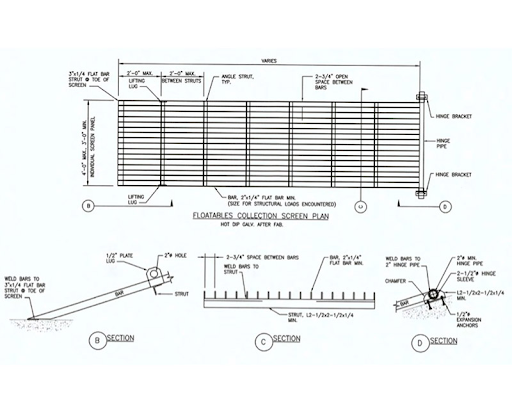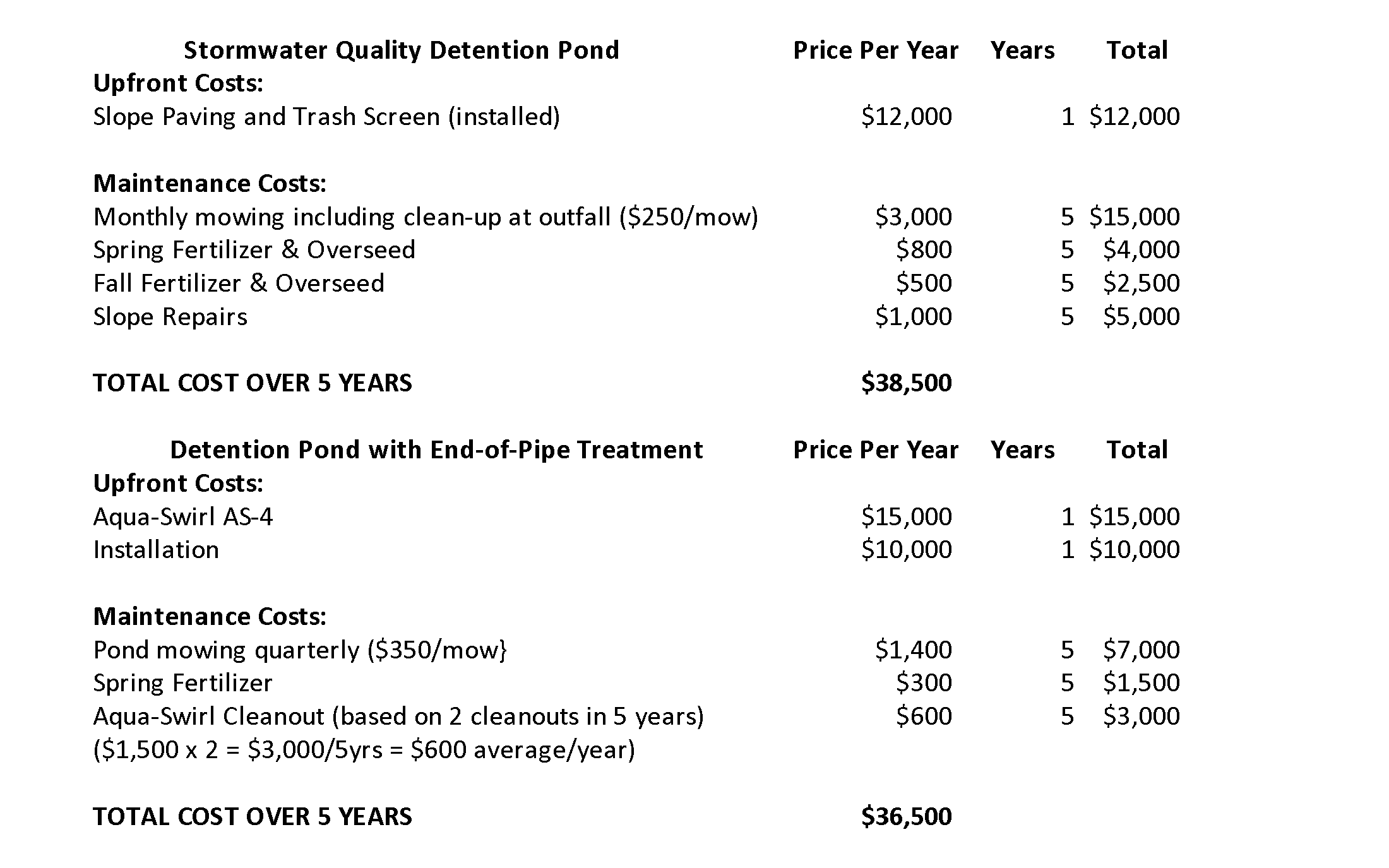As a stormwater consultant, I’m often asked why we rarely advise using a detention pond as a dual-purpose (detention and stormwater quality) pond. On the surface, it would make sense that since detention is already required, we could simply add a trash screen or cage along with a restrictor and kill two birds with one stone. A cost savings to be sure. But is it really?
Today we’ll take a look at the real cost of ownership, comparing a combination pond (detention with a trash screen for stormwater quality) to a detention pond with hydrodynamic separation as a stormwater quality feature. This comparison will include the upfront cost of installation as well as a 5-year cost of ownership for both systems.
To be fair we will use the same site for our comparison. Our test site is 10 acres, requiring .75 acre-feet per acre of detention. Stormwater quality is based on impervious areas being treated. For our purposes let’s assume the whole 10 acres is being treated.
We’ll start with the dual-purpose pond using a trash screen. Below is a typical example of a well-thought-out trash screen. Notice that the openings are 2 ¼ max. If you measure a water bottle or soda can you’ll understand why.

To be effective, this trash screen needs to be surrounded by sloped paving. This gives the screen a place to nest as well as attachment points for the hinged end in case the screen needs to be lifted for maintenance or repair. These screens are sized based on the detention volume of the pond. Our sample pond has a perimeter of 600 feet and a depth of 12 ft. A typical trash screen with slope paving for a pond of this size would cost $10,000-$15,000. For our purposes, we will use $12,000 as our initial cost for water quality in the pond.
For comparison, we will use an Aquaswirl AS-4. This is a 4t. diameter hydrodynamic separator located at the pond outfall prior to discharge into the public drainage. Substituting the Aquaswsirl with another manufacturer’s unit will give you the same 4 ft. diameter tank. Unfortunately, pricing is all over the board as these systems are made of differing materials from concrete to plastic to steel. Truth be told, the Aquaswirl unit is very competitively priced. For our comparison, this gives us a conservative cost of $15,000. But remember we still need to account for installation, which adds about $10,000 to the cost.
If we were to stop here you would most likely surmise that the trash screen is the way to go. The cost being half that of an end-of-pipe system. But this is only part of the picture. The cost of ownership, including maintenance, must be considered if we are to provide a fair analysis. To do so we will look at the cost to maintain a 1-acre stormwater quality pond vs. the cost to maintain both a 1-acre detention pond as well as a 4 ft. diameter hydrodynamic separator.
At this point, you may be wondering what the difference is (if any) between a detention pond and a stormwater-quality pond. They are designed the same and both serve primarily as detention. The only difference is the trash screen and sloped paving. In reality, there is nothing shockingly different about the construction of these ponds. The real difference is in the maintenance burden.
Detention ponds (whether straight detention or combined with stormwater quality) are typically located at the back of the property, preferably out of sight. The reasons are obvious. Detention ponds are not water features. They do nothing to add value to the property but do require capital to maintain. A necessary evil in the eyes of property owners to be sure! So when faced with this maintenance burden, property owners look for the least expensive option, which is often $0. Out of sight, out of mind. Right. And while this isn’t a sustainable approach, (vegetation will eventually choke the pond, requiring extensive rehab just to drain properly again) you may be surprised at how often this happens. Sometimes it is a conscious decision. But most often a lack of understanding or available information on the owner’s part. And, believe it or not, some property owners aren’t even aware that the pond at the back of the property belongs to them. For our purposes let’s assume that the owner is going to do the minimum to keep the detention pond functional. But this minimum won’t be enough if the pond contains a stormwater quality feature. So for comparison, to be fair, we have to include the cost of hydrodynamic separator maintenance as well.
We’ll start with the combination pond utilizing a trash screen for stormwater quality. When dealing with stormwater quality in a detention pond extra maintenance is necessary since we have a screen that is subject to clogging. To keep the water flowing properly mowing should be performed monthly. Monthly mowing is necessary to keep the cuttings small enough to pass through the screen, keeping clogging to a minimum. Less frequent mowing (quarterly) allows for 3 months of growth which (in the summer months especially) equates to thicker stalks and denser vegetation. This thicker vegetation is often too large to pass through the screens and starts to dam up the pond. The resulting standing water promotes cattail growth as well as undesirable trees and bushes that can further disrupt the flow at the outfall structure. Even the smallest amount of standing water invites mosquitoes, snakes, and even rats (yes, you heard that right) to the party. Additional maintenance includes fertilizing the pond twice/yr. as well as bi-annual overseeding with Bermuda in spring and Rye in fall. These supporting maintenance items are necessary to keep the pond slopes healthy and promote a solid stand of grass. Without this maintenance, the stormwater quality pond may not be permittable. And depending on local ordinances may need extensive repairs to be brought back into compliance. The bottom line is that stormwater quality ponds are generally scrutinized to a much greater extent than straight detention. So more care needs to be taken to keep these ponds in “as-built” condition. The annual cost breakdown for our stormwater quality pond including a $1000 budget for typical slope repairs is as follows:
Monthly mowing including clean-up at outfall ($250/mow) $3000.00
Spring fertilizer & overseed $ 800.00
Fall fertilizer & overseed $ 500.00
Slope repairs $1000.00
TOTAL $5200.00
Now we’ll look at the maintenance needs of a non-stormwater quality pond. It makes sense that the maintenance above would hold true for any pond, right? But if the detention pond doesn’t have a screen, a permitting requirement, or any oversight we don’t need to be as diligent with maintenance. Now I’m not suggesting eliminating maintenance altogether. The result of that experiment would be a jungle full of undesirable critters and undesirable growth, resulting in clogging of the outfall, subjecting the property to potential flooding. With standard detention ponds, we’re just looking for minimum maintenance consisting of quarterly mowing and spring fertilizer. The idea here is just to feed the pond at least once/yr. and manage the growth to keep the water flowing. The mowing cost is a little more than the monthly price above but the growth has almost tripled in size after 3 months. Outfall pipes are typically around 24” and so the larger thatch from less frequent mowings should easily be able to pass to the public drainage. Cost for this maintenance:
Quarterly mowing ($350/mow) $1400.00
Spring fertilizer $ 300.00
TOTAL $1700.00
Now to be fair we also need to look at the estimated maintenance cost for our hydrodynamic separator if we are to be fair. Since we are looking at a 5-year cost we can assume that the separator will need 2 cleanouts in 5 years. This is based on our experience with these types of units as a maintenance company. Of course this is use-dependent. If you have a property that generates a lot of trash or sediment your cleaning frequency may be more than once every 2-3 years. If the hydrodynamic separator is located at the pond outfall the system may not need cleaning for 5 years. But in our experience, this is a good starting point. The cost to clean out an Aquaswirl AS-4 is approximately $1500.00. In your market, it could be more or less. This particular system holds less than 1000 gallons so we are using $1.50/gallon as a cost basis. Conservative to be sure.
Now let’s do some math and put it all together to include the additional capital costs as well as 5 years of maintenance for both systems.

Based on the numbers above you can see that over a 5 year period the hydrodynamic separator option is slightly better. But this just gives us a 5-year cost. So what about after 5 years? Remember that maintenance for the detention pond is $5,200.00/yr. in perpetuity and the hydrodynamic separator with detention $2,200.00/yr. This equates to a $3000 additional maintenance cost per year as long as you own the property. Another 5 years and the added expense for the “cheap” combination pond is $15,000.00 more than the pond/hydrodynamic separator option.
The takeaway here is that what glitters isn’t always gold. It is incumbent on decision-makers to see past the upfront cost and instead look at the whole picture, including maintenance. It is only with this information that we can make the right decision for the owner, as he/she is ultimately saddled with the maintenance burden and ultimately the cost of ownership. And if we are doing right by the owner there is no other option. If you would like a cost breakdown for your next project feel free to contact us. We have done hundreds of these and would be more than happy to do so for you.
